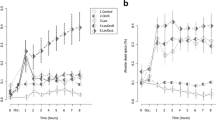Summary
This study investigated the feasibility and effects of organ bath to be used for detection of bronchial function of non-heart-beating donor (NHBD) lung after 1-h warm ischemia. Sixteen Swedish pigs were divided into two groups randomly: heart-beating donor (HBD) group and NHBD with 1-h warm ischemia (NHBD-1 h) group. The bronchial rings whose lengths and inner diameters were both 1.5 mm were obtained from isolated left lungs of all the pigs. Acetylcholine, arachidonic acid natrium and papaverine were used to test and compare the contractile and relaxant function of bronchial smooth muscles and epithelium-dependent relaxation (EpiDR) response between HBD and NHBD-1 h groups. The results showed that there was no significant difference in the values of bronchial precontraction between HBD and NHBD-1 h groups (5.18±0.07 vs 5.10±0.11 mN, P>0.05). No significant difference in the values of EpiDR responses between HBD and NHBD-1 h groups (1.26±0.05 vs 1.23±0.07 mN, P>0.05) was observed either. During the process of EpiDR induction, the rings had no spontaneous relaxation in two groups. In addition, papaverine solution completely relaxed the bronchial smooth muscles of all bronchial rings. It was concluded that after warm ischemia for 1 h, the contractile and relaxant abilities of bronchial smooth muscles, and the epithelium-dependent adjustment both kept intact. Organ bath model could be a liable and scientific way to evaluate the bronchial function of NHBD lung.
Similar content being viewed by others
References
Meyers BF, Lynch J, Trulock EP, et al. Lung transplantation: a decade of experience. Ann Surg, 1999,230:362–370
Bando T, Date H, Minami M, et al. First registry report: lung transplantation in Japan: The Japanese Society of Lung and Heart-Lung Transplantation. Gen Thorac Cardiovasc Surg, 2008,56:17–21
Steen S, Sjoberg T, Pierre L, et al. Transplantation of lungs from a non-heart-beating donor. Lancet, 2001,357: 825–829
Dark JH. Lung transplantation from the non-heart-beating donor. Transplantation, 2008,86:200–201
Garrity ER, Moore J, Mulligan MS, et al. Heart and lung transplantation in the United States, 1996–2005. Am J Transplant, 2007,7:1390–1403
Sung RS, Galloway J, Tuttle-Newhall JE, et al. Organ donation and utilization in the United States, 1997–2006. Am J Transplant, 2008,8:922–934
Orens JB, Boehler A, de Perrot M, et al. A review of lung transplant donor acceptablity criteria. J Heart Lung Transplant, 2003,22:1183–1200
Pierre AF, Sekine Y, Hutcheon MA, et al. Marginal donor lungs: a reassessment. J Thorac Cardiovasc Surg, 2002,123:421–427
Oto T, Levvey BJ, Whitford H, et al. Feasibility and utility of a lung donor score: correlation with early post-transplant outcomes. Ann Thorac Surg, 2007,83:257–264
Bowdish ME, Barr ML, Starnes VA. Living lobar transplantation. Chest Surg Clin N Am, 2003,13:505–524
Date H, Kusano KF, Matsubara H, et al. Living-donor lobar lung transplantation for pulmonary arterial hypertension after failure of epoprostenol therapy. J Am Coll Cardiol, 2007,50:523–527
Pierre AF, Keshavjee S. Lung transplantation: donor and recipient critical care aspects. Curr Opin Crit Care, 2005, 11:339–344
Starzl TE, Marchioro TL, Von Kaulla KN, et al. Homo-transplantation of the liver in humans. Surg Gynecol Obstet, 1963,117:659–676
Hardy JD, Webb WR, Dalton ML Jr, et al. Lung homo-transplantation in man. JAMA, 1963,186:1065–1074
Oto T. Lung transplantation from donation after cardiac death (non-heart-beating) donors. Gen Thorac Cardiovasc Surg, 2008,56:533–538
Oto T, Levvey B, McEgan R, et al. A practical approach to clinical lung transplantation from a Maastricht Category III donor with cardiac death. J Heart Lung Transplant, 2007,26:196–199
Tazzeo T, Zuo J, Ellis R, et al. Silk suture used in standard organ bath studies contracts upon exposure to Krebs buffer. J Pharmacol Toxicol Methods, 2002,48:179–183
Perrault LP, Nickner C, Desjardins N, et al. Improved preservation of coronary endothelial function with Celsior compared with blood and crystalloid solutions in heart transplantation. J Heart Lung Transplantat, 2001,20:549–558
de Antonio DG, Marcos R, Laporta R, et al. Results of clinical lung transplant from uncontrolled non-heart-beating donors. J Heart Lung Transplant, 2007,26:529–534
Egan TM, Lambert CJ Jr, Reddick R, et al. A strategy to increase the donor pool: use of cadaver lungs for transplantation. Ann Thorac Surg, 1991,52:1113–1121
Van Raemdonck DE, Rega FR, Neyrinck AP, et al. Non-heart-beating donors. Semin Thorac Cardiovasc Surg, 2004,16:309–321
Snell GI, Oto T, Levvey B, et al. Evaluation of techniques for lung transplantation following donation after cardiac death. Ann Thorac Surg, 2006,81:2014–2019
Van Raemdonck DE, Jannis NC, De Leyn PR, et al. Warm ischemic tolerance in collapsed pulmonary grafts is limited to 1 hour. Ann Surg, 1998,228:788–796
Steen S, Ingemansson R, Budrikis A, et al. Successful transplantation of lungs topically cooled in the non-heart-beating donor for 6 hours. Ann Thorac Surg, 1997,63:345–351
Egan TM. Non-heart-beating donors in thoracic transplantation. J Heart Lung Transplant, 2004,23:3–10
Rega FR, Neyrinck AP, Verleden GM, et al. How long can we preserve the pulmonary graft inside the non-heart-beating donor? Ann Thorac Surg, 2004,77:438–444
Oto T, Rowland M, Griffiths AP, et al. Third-time lung transplant using extended criteria lungs. Ann Thorac Surg, 2007,84:642–644
Snell GI, Levvey BJ, Oto T, et al. Early lung transplantation success utilizing controlled donation after cardiac death donors. Am J Transplant, 2008,8:1282–1289
Author information
Authors and Affiliations
Rights and permissions
About this article
Cite this article
Yang, Y., Zhao, S., Liao, Q. et al. Detection of bronchial function of NHBD lung following one-h warm ischemia by organ bath model. J. Huazhong Univ. Sci. Technol. [Med. Sci.] 29, 340–343 (2009). https://doi.org/10.1007/s11596-009-0315-x
Received:
Published:
Issue Date:
DOI: https://doi.org/10.1007/s11596-009-0315-x




